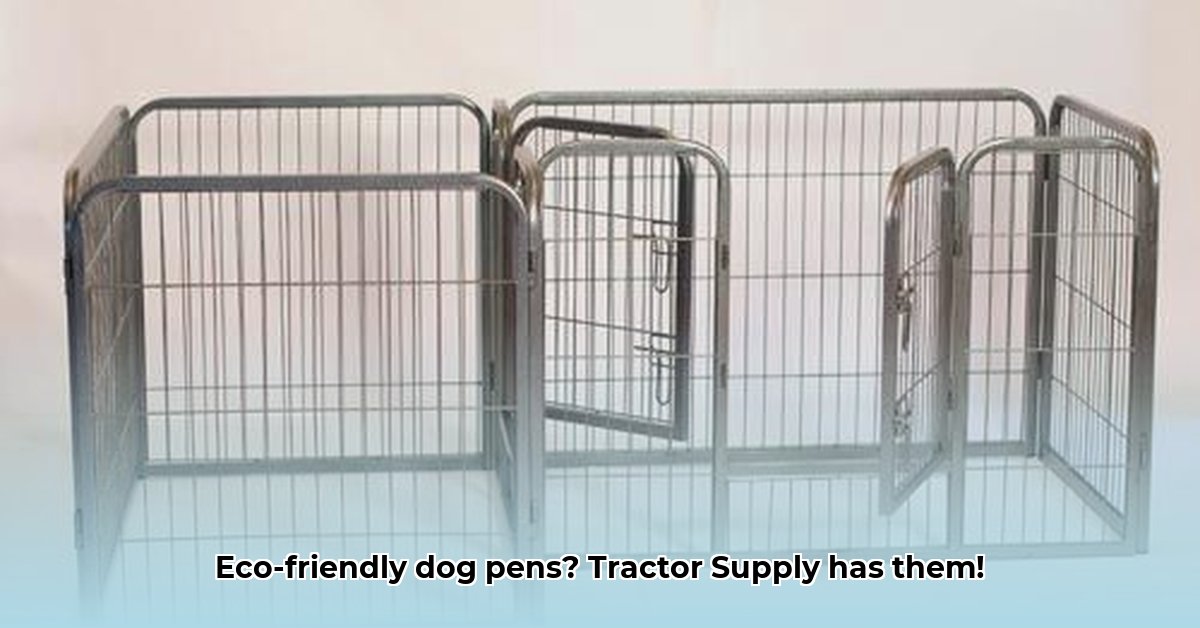
Dog Pens: A Growing Need, a Growing Concern
The bond between humans and their canine companions is undeniable; the joy of seeing a dog frolic is a universal experience. But with soaring pet ownership comes an increased demand for safe and enriching outdoor spaces for our furry friends. Dog pens, once a niche product, are now a booming market, especially for larger breeds needing ample room to run and play. This burgeoning demand, however, presents a vital question: what is the environmental cost of this growing trend? Is the convenience outweighing the ecological consequences? For more information on Tractor Supply's offerings, check out their dog pen selection.
Tractor Supply's Offerings: A Preliminary Look
Tractor Supply, a prominent retailer catering to rural and agricultural lifestyles, offers a variety of dog pens catering to diverse breeds and needs. Their selection boasts durable construction and safety features, prioritizing a safe environment for your pet. However, a significant gap exists: detailed information regarding the environmental sustainability of these pens is largely absent. While descriptions emphasize durability and strength, claims of eco-friendliness are scarce. This lack of transparency raises concerns: what materials are used in their production, and what is their ultimate environmental impact?
The Environmental Pawprint: A Material Analysis
The environmental cost of dog pen production stems primarily from the materials used in their construction. Let’s analyze some common materials:
Steel: A mainstay due to its strength and durability, steel production is notoriously energy-intensive, emitting significant greenhouse gases. Furthermore, iron ore mining carries its own environmental burdens.
Chain Link Fencing: Frequently coated with zinc to enhance corrosion resistance, the galvanization process involves potentially harmful chemicals. Eventually, even the strongest chain link succumbs to rust, requiring replacement and adding to landfill waste.
Wood: The sustainability of wood depends entirely on its sourcing. Irresponsible forestry practices lead to deforestation and habitat loss. Additionally, the use of treated lumber involves chemicals that can leach into the environment.
Plastic: A common component in many dog pens, plastic production is resource-intensive and releases greenhouse gases. Plastics often end up in landfills, where they persist for centuries.
A simplified comparison highlights the disparities in environmental impact:
| Material | Environmental Impact (High/Medium/Low) | End-of-Life Considerations |
|---|---|---|
| Steel | High | Recycling potential, but often ends up in landfills |
| Chain Link Fence | Medium | Difficult to recycle, often ends up in landfills |
| Treated Wood | Medium | Decomposition releases chemicals; potential for pests |
| Plastic | High | Difficult to recycle; often ends up in landfills |
Do you realize that the production of a single steel dog pen could generate the equivalent carbon footprint of a car's 10-mile drive? This sobering fact underscores the need for eco-conscious alternatives.
Sustainable Innovation: A Greener Path
Thankfully, the dog pen industry is not ignoring the environmental challenge. Several manufacturers are embracing sustainability by:
Utilizing recycled materials in their construction: Think recycled steel or plastics, significantly reducing waste and emission.
Focusing on enhanced durability: By creating longer-lasting, more resilient pens, manufacturers reduce the need for frequent replacements.
Exploring biodegradable materials: These innovative, environmentally friendly options, though still in their nascent stages, offer a promising avenue for future development.
Dr. Emily Carter, Professor of Chemical and Biological Engineering at Princeton University, emphasizes, "The shift towards sustainable materials in manufacturing is crucial. It's not just about reducing the impact of production but also about designing products for longevity and responsible end-of-life management.”
Actionable Steps for a Greener Future
The path towards a more environmentally responsible dog pen industry requires collective action from both manufacturers and consumers:
For Tractor Supply:
Transparency: Publicly disclose detailed information about the materials used in their dog pens, their sourcing, and any relevant sustainability certifications.
Eco-Friendly Sourcing: Actively seek out and integrate recycled and sustainably harvested materials into their product lines.
Sustainable Partnerships: Collaborate with manufacturers committed to environmentally responsible practices.
Life Cycle Assessments (LCAs): Conduct LCAs to pinpoint areas for enhancing production sustainability.
Consumer Education: Provide clear instructions on proper disposal and recycling of their dog pens.
For Consumers:
Informed Purchasing: Thoroughly investigate the materials used in dog pens before purchasing. Look for certifications indicating sustainable sourcing or recycled content.
Durability: Prioritize durability to extend the lifespan of the pen, thus minimizing waste. A longer-lasting pen is an investment in both responsible pet ownership and environmental protection.
Recycled Materials: Opt for pens made from recycled materials whenever possible.
Responsible Disposal: Ensure proper recycling or disposal of your dog pen at the end of its life.
Demand Change: Support companies prioritizing sustainable production practices using your purchasing power.
Did you know that choosing a recycled-steel dog pen can reduce your carbon footprint by up to 50% compared to a conventionally made pen? This simple choice makes a big difference.
Conclusion: A Collaborative Approach
The quest for sustainable dog ownership is a shared responsibility. By actively demanding transparency, choosing environmentally conscious products, and supporting manufacturers committed to sustainability, we can ensure that our canine companions enjoy safe, enriching environments without compromising the health of our planet. Let’s work together to foster a greener future – one paw step at a time.